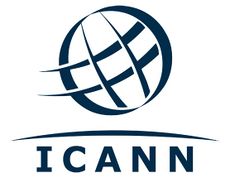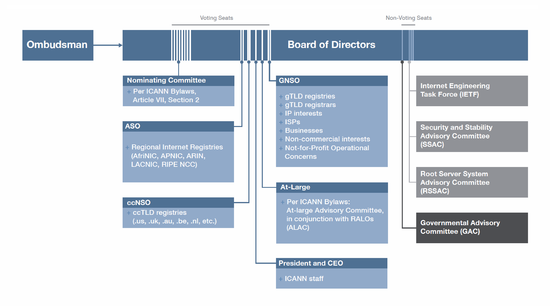ICANN 101
Welcome to the world of ICANN! If you are new, or even if you aren't, here are a list of important terms that you may need to know.
ICANN
ICANN stands for the "Internet Corporation for Assigned Names and Numbers." It is a private, non-profit organization for the management of the Internet DNS, IP Addresses and Autonomous System Numbers, and the structures that underlie them. It runs on an international, multi-stakeholder model.
|
MAIN ARTICLE: SEE ALSO: |
ICANN Organizational Chart |
GNSO
- Main article: GNSO
- The GNSO is an ICANN Supporting Organization. It supports the ICANN Board by developing policies, forming consensus, and making recommendations related to gTLDs.
ccNSO
- Main article: ccNSO
- The ccNSO is an ICANN Supporting Organization. It supports the ICANN Board by developing policies, forming consensus, and making recommendations related to ccTLDs.
ASO
- Main article: ASO
- The ASO is an ICANN Supporting Organization. It supports the ICANN Board by developing policies, forming consensus, and making recommendations related to Internet Protocol and addresses.
GAC
- Main article: GAC
- The GAC, or Government Advisory Committee, is a committee made up of representatives from various governments to advise the ICANN Board on public policy issues, national laws, and international agreements.
NomCom
- Main article: Nominating Committee
- The Nominating Committee, or NomCom, is in charge of selecting various ICANN officers. It is designed to operate independently of all other ICANN Bodies, and to act in the interest of the global internet community.
Registry
- Main article: Registry
A registry is the database of all domain names registered under a certain TLD. A registry operator, also called a NIC or network information center, is responsible for managing this database. They contract with registrars, who are accredited to sell domains under the TLD.
Registrar
- Main article: Registrar
A registrar is a company that is authorized to sell domain names.
Registrant
A registrant is a person who has registered a domain name through a registrar.
DNS
The DNS, or Domain Name System, is the system that translates between alphanumeric domain names and IP Addresses.
TLD
- Main article: TLD
A TLD, or Top Level Domain, is the last part of a domain name, for example: .com, .net, .org. The two most prominent types of TLDs are gTLDs and ccTLDs.
gTLD
- Main article: gTLD
A Generic Top Level Domain, or gTLD, is basically any TLD that is not a ccTLD. Previously, gTLDs were limited to being three or more characters. But with the addition of the New gTLD program, two character gTLDs may now be registered. Examples of gTLDs include .com, .org, and .info. sTLDs, such as .travel, and GeoTLDs, such as .asia and .cat, are a subset of gTLDs.
New gTLD Program
- The new gTLD Program is a newly approved process by which ICANN will be accepting applications to add new TLDs to the Root Zone. Check out our New gTLD Resources page.
ccTLD
- Main article: ccTLD
A Country-Code Top Level Domain, or ccTLD, is a TLD with two characters, specifically designed for a particular country, sovereign state or autonomous territory. .uk, .de, and .cn are all examples of ccTLDs.
IP
- Main article: Internet Protocol
- See also: IPv4, IPv6, Internet Protocol Suite
Internet Protocol is the means by which data is sent from one computer to another via an Internet connection.


